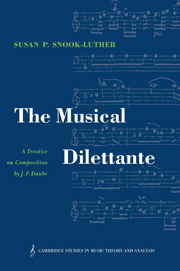Book contents
- Frontmatter
- Contents
- Foreword
- Translator's preface
- Introduction
- THE MUSICAL DILETTANTE: A TREATISE ON COMPOSITION (1773)
- Preface
- 1 Harmony in general
- 2 The three different motions of the voices
- 3 Combining two voices
- 4 Combining three voices
- 5 Combining four voices
- 6 Composition in five and more parts
- 7 Variation
- 8 Imitation
- 9 Canon
- 10 Simple fugue
- 11 Double counterpoint
- 12 Double fugue
- Bibliography
- Index
Preface
Published online by Cambridge University Press: 15 October 2009
- Frontmatter
- Contents
- Foreword
- Translator's preface
- Introduction
- THE MUSICAL DILETTANTE: A TREATISE ON COMPOSITION (1773)
- Preface
- 1 Harmony in general
- 2 The three different motions of the voices
- 3 Combining two voices
- 4 Combining three voices
- 5 Combining four voices
- 6 Composition in five and more parts
- 7 Variation
- 8 Imitation
- 9 Canon
- 10 Simple fugue
- 11 Double counterpoint
- 12 Double fugue
- Bibliography
- Index
Summary
A well-laid foundation in thorough-bass can rightfully be called the guide to composition. The reason is that thorough-bass consists of the knowledge of chords and their succession. Composition, on the other hand, is the skillful combining of these chords with melody in such a way that the expression or depiction of the affects may result. Furthermore, every melody is constructed of tones which are intervals derived from chords, although, strictly speaking, this does not take into account the passing tones which are frequently required for the formation of the melody.
It is, to be sure, actually quite possible to have the practical science of thorough-bass at one's fingertips without understanding composition, but it is impossible to be able to compose without knowing the rudiments of thorough-bass. For to invent a certain melody and set a bass to it by ear is only the very slightest part of the art of composition. To do this, of course, one does not need to understand the theory of thorough-bass, although without this knowledge one is certainly not even in a position to provide the shortest melody with a well-founded accompaniment. And even should one happen upon a good accompaniment by frequently hearing similar passages, one is still at a loss to suggest the slightest basis for it. Thus it is always safer to learn thorough-bass solidly, and in its entire range, before venturing to compose.
- Type
- Chapter
- Information
- The Musical DilettanteA Treatise on Composition by J. F. Daube, pp. 35 - 36Publisher: Cambridge University PressPrint publication year: 1992



